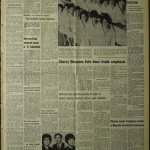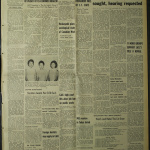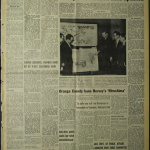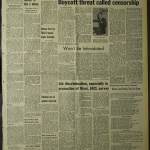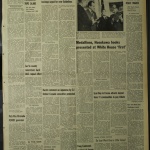Americans of Japanese Ancestry: A Study of Assimilation in the American Community (book)
| Title | Americans of Japanese Ancestry: A Study of Assimilation in the American Community |
|---|---|
| Author | Forrest E. LaViolette |
| Original Publisher | Canadian Institute of International Affairs |
| Original Publication Date | 1945 |
| Pages | 185 |
| WorldCat Link | http://www.worldcat.org/title/americans-of-japanese-ancestry-a-study-of-assimilation-in-the-american-community/oclc/988195/editions?editionsView=true&referer=br |
Americans of Japanese Ancestry: A Study of Assimilation in the American Community by Forrest E. LaViolette examines Japanese American family and community life in the pre-World War II period until 1941. LaViolette specifically focuses upon the adjustment problems facing the Nisei in the United States "resulting from a bi-racial, bi-cultural milieu in which racial discrimination is a compelling fact of life" prior to their incarceration. [1] He only briefly mentions the mass incarceration of Japanese Americans in the final chapter despite serving as a community analyst for the War Relocation Authority (WRA) at Heart Mountain for six months in 1943.
LaViolette's Educational Background
Laviolette received his bachelor's degree from Reed College in 1933 and wrote a thesis entitled "Japanese Nationalism, A Social Study." In 1936, he graduated with a degree in sociology from the University of Chicago and Americans of Japanese Ancestry was originally published in 1945 based on his dissertation. From 1936 to 1940, LaViolette was a sociologist at the University of Washington conducting research on Japanese Americans before serving as a community analyst at Heart Mountain. After the war, LaViolette was a faculty member at McGill University and was the chairman of the sociology department at Tulane University.
As one of the early studies focusing on racial discrimination and identity within the Japanese community, LaViolette began gathering the material for this study in the summer of 1934 researching in areas like Portland, San Francisco, Seattle, and Los Angeles where Japanese Americans had established a number of communities before their incarceration. His research was supported by the Canadian Social Science Research Council and the Research Committee of the Canadian Institute of International Affairs, as both organizations supported "further research among the two groups of Japanese, those in Canada and those in the United States, for these are . . . the only two countries in the world concerned with problems of assimilating such a divergent group as the immigrant Japanese and their children" as both populations experienced social and economic discrimination. [2]
Book Organization
The book begins by describing the two principal groups in the Japanese American community—the Issei and Nisei—and the organization of the family as well as vocational, marriage, and community issues. As one of the early works on Japanese American immigrant and community life prior to World War II, LaViolette noted that much of the material on the topic was available only in "scattered references" although he was influenced by John Embree 's Suye Mura and the publication of the Survey of Race Relations documents from the Institute of Social and Religious Research of New York City. In his research, LaViolette utilizes information and sources from Japan to examine processes of social change and prevailing traditions. While some of this cultural information may be useful in certain instances such as in understanding the role of intermediaries ( nakōdo ) in marriage practices, not all traditional practices were replicated in the United States. For example, scholar John Embree notes that sources such as Onna Daigaku that describes the qualities of an ideal, submissive, upper-class wife, "does not truly reflect even upper-class Japanese life today and certainly does not apply to rural Japan, whence many immigrants came to this country" as class influenced the transmission of certain practices. [3]
However, as a result of their cultural heritage, Japanese Americans have experienced a history of discrimination and "marginalism" in the pre and postwar period that LaViolette points out influenced assimilation, notions of identity, and patterns of settlement. [4] One critical event, however, that LaViolette does not carefully examine is the impact of the incarceration experience on the Japanese American community and the multiplicity of identities to emerge from the camps that challenged the dichotomy of Issei vs. Nisei and corresponding notions of loyalty. This fact was pointed out by reviewer Galen Fox who noted that "LaViolette terminated his field work before the evacuation of the Japanese from the West Coast, and therefore did not forecast the influence of that epochal event on the Americanization of the nisei." [5] As such, LaViolette provides an overly simplistic understanding of loyalty and the draft issue among Issei and Nisei noting that "the prospect of serving in the American Army was looked upon favourably. It was openly welcomed by the nisei as the best opportunity ever presented for settling the questions of duality citizenship and ambiguous loyalties." [6] LaViolette fails to mention the controversy surrounding the draft issue within the camps and the challenges surrounding declarations of loyalties in part due to the bicultural identity of many Japanese Americans. Regional differences are also ignored as Japanese Americans in Hawai'i, the Pacific Northwest, California, and other areas seemingly share the same experiences and notions of identity despite the fact that there were clear differences before, during, and after the war.
In expanding on the issues raised in Edward K. Strong, Jr.'s The Second-Generation Japanese Problem (1934), Laviolette's study provides important insights into the prewar Japanese American community and the challenge of clearly defining Japanese American identity. How these notions of identity changed during the war, however, remains a critical area of study for Japanese American scholars who are interested in examining the evolution of ethnic identity and the historical events that shaped these ideas.
Find in the Digital Library of Japanese American Incarceration
Americans of Japanese Ancestry: A Study of Assimilation in the American Community
This item has been made freely available in the Digital Library of Japanese American Incarceration , a collaborative project with Internet Archive .
For More Information
"Forrest E. LaViolette papers, 1933-1943." Howard-Tilton Memorial Library Special Collections, Tulane University.
"Guide to the Forrest E. LaViolette Slides and Photographs Apr. 1 to Oct. 1, 1943." University Libraries, University of Washington. Robinson, Greg. After Camp: Portraits in Midcentury Japanese American Life and Politics . Berkeley: University of California Press, 2012.
Strong, Edward K. The Second Generation Japanese Problem . 1934. New York, Arno Press, 1970.
Reviews
Angus, H. F. The Canadian Journal of Economics and Political Science / Revue canadienne d'Economique etde Science politique 12.4 (Nov. 1946): 537–38.
Embree, John F. American Journal of Sociology 52.3 (Nov. 1946): 285–86.
Fisher, Galen M. Pacific Affairs 19.4 (Dec. 1946): 451–52.
Masuoka, Jitsuichi. Social Forces 25.4 (May 1947): 455–57.
Smith, Elmer R. Pacific Citizen , Sept. 21, 1946, 5.
Footnotes
- ↑ Forrest E. Laviolette, Americans of Japanese Ancestry: a Study of Assimilation in the American Community (New York: Arno Press, 1978), v.
- ↑ Laviolette, Americans of Japanese Ancestry , v-vi.
- ↑ John F. Embree, review of Americans of Japanese Ancestry: A Study of Assimilation in the American Community , by Forrest E. LaViolette, American Journal of Sociology 52.3 (Nov. 1946), 285.
- ↑ Laviolette, Americans of Japanese Ancestry , 175.
- ↑ Galen M. Fisher, Review of Americans of Japanese Ancestry: A Study of Assimilation in the American Community , by Forrest E. LaViolette, Pacific Affairs 19.4 (Dec., 1946), 452.
- ↑ LaViolette, Americans of Japanese Ancestry , 147.
Last updated Dec. 4, 2023, 5:28 p.m..



